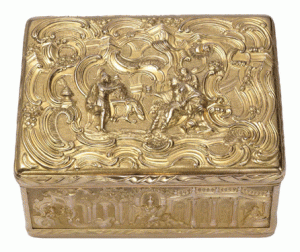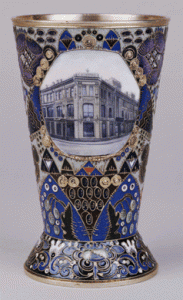A La Vieille Russie Recreates Its Paris Years At Didier Aaron

Allegorical repousse gold snuffbox by George Fredrich Eckard (1733-1765), St Petersburg, circa 1750. By tradition, a personal gift from Empress Elizabeth I to her secret husband, Count Alexis Razumovsky. Eckard both designed and executed the Russian Imperial Crown
Source: Antiques & The Arts Online
By Laura Beach
A La Vieille Russie is lifting the cover on a dealer’s most closely guarded secret: its guest book, or livre d’or, containing the names of dozens of its best clients, colleagues and sources in the 1920s and 1930s.
The revelations are part of a selling exhibition that the Manhattan dealers in Russian art and antiques are mounting at Didier Aaron & Cie in Paris. Loosely timed to coincide with the Biennale des Antiquaires, the display opens September 16 at Aaron’s galleries at 118 Faubourg Saint-Honoré, minutes away from A La Vieille Russie’s former French headquarters.
“A La Vieille Russie in Paris” explores the fertile interwar years when émigré artists and aristocrats made Paris the crossroads of Russian culture. Relying on period photographs and company records, A La Vieille Russie collaborated with the high-profile French designer Jacques Grange on the installation that is meant to evoke the shop in its early years. Fabergé objets de vertu dominate the 140-object display, which also features Eighteenth Century Winter Palace gold and silver, imperial porcelain, icons and paintings.

Fabergé presentation vase, workmaster Feodor Rückert, circa 1912. Gilded silver and cloisonné enamel vase in the Old Russian style, decorated on one side with a view of Fabergé’s Moscow branch and on the other with an inscription commemorating 25 years of the Fabergé presentation vase, workmaster Feodor Rückert, circa 1912.
The revelations are part of a selling exhibition that the Manhattan dealers in Russian art and antiques are mounting at Didier Aaron & Cie in Paris. Loosely timed to coincide with the Biennale des Antiquaires, the display opens September 16 at Aaron’s galleries at 118 Faubourg Saint-Honoré, minutes away from A La Vieille Russie’s former French headquarters.
“A La Vieille Russie in Paris” explores the fertile interwar years when émigré artists and aristocrats made Paris the crossroads of Russian culture. Relying on period photographs and company records, A La Vieille Russie collaborated with the high-profile French designer Jacques Grange on the installation that is meant to evoke the shop in its early years. Fabergé objets de vertu dominate the 140-object display, which also features Eighteenth Century Winter Palace gold and silver, imperial porcelain, icons and paintings.
Needing hard currency after the 1917 Revolution, the Soviets enlisted a network of dealers, auctioneers and agents in Europe and the United States to sell treasures confiscated from palaces, churches and monasteries. It was only after the Soviet archives opened in 1991 that the full story, meticulously told in Treasures Into Tractors: The Selling of Russia’s Cultural Heritage, 1918–1938 (Hillwood Museum, 2009) became known. Sales peaked between 1928 and 1932. The government reinstated its export ban in 1938.
Along with Wartski in London and Armand Hammer in New York, A La Vieille Russie cultivated the worldwide taste for Russian artifacts, especially Fabergé. A La Vieille Russie founder Jacques Zolotnitsky and his nephew Léon Grinberg collaborated on the landmark exhibition of Russian art in Brussels in 1928. Zolotnitsky protégé Alexander Schaffer, who opened A La Vieille Russie’s New York branch in 1941, passed the mantle of serious scholarship to his sons, Paul and Peter Schaffer, and to his grandson, Mark Schaffer.
In a Fifth Avenue office cluttered with exhibition catalogs and dominated by a massive safe, Mark Schaffer offers me the leather-bound, gilt-embossed album that is splashed from front to back with the signatures of Russian aristocrats, Hollywood royalty and art world glitterati, from Marlene Dietrich and Douglas Fairbanks Jr to Salvador Dali and Anna Pavlova. Marjorie Merriweather Post signed in 1937, an auspicious year marking her entrée into the Russian art market with her then-husband, Joseph E. Davies, US Ambassador to the Soviet Union.
A favorite page, dated 1929, bears inscriptions by Sergei Diaghilev (1872–1929), founder of the Ballets Russes, and dancer and choreographer Serge Lifar (1905–1986), who added subsequent notations in 1935 and 1937.
“The world is not the same as it was,” says Mark Schaffer, reflecting on the time when a dealer’s gallery was his salon. A La Vieille Russie swirled with the comings and goings of Moscow Art Theatre actor Vassily Katchalov, designer Mislav Dobujinsky, Grand Duchess Maria Pavlovna, art historian Alexandre Benois and basso Fyodor Chaliapin, who added to the book a fond tribute to his dear friend Zolotnitsky.
Printed in French and Russian, a 50-page, illustrated color catalog accompanies the exhibition. The starstruck are invited to add their own inscriptions to an updated livre d’or, made especially for the show.
“A La Vieille Russie in Paris” continues through October 8. For further information, www.didieraaron.com or 011 33 1 47 42 47 34.
Antiques and the Arts Editorial Content
Copyright © 2010 Bee Publishing Company


745 Fifth Avenue, 4th Floor, NYC 10151
1.212.752.1727
Terms of Sale | Terms of Use | Privacy Policy
© A La Vieille Russie | Site by 22.